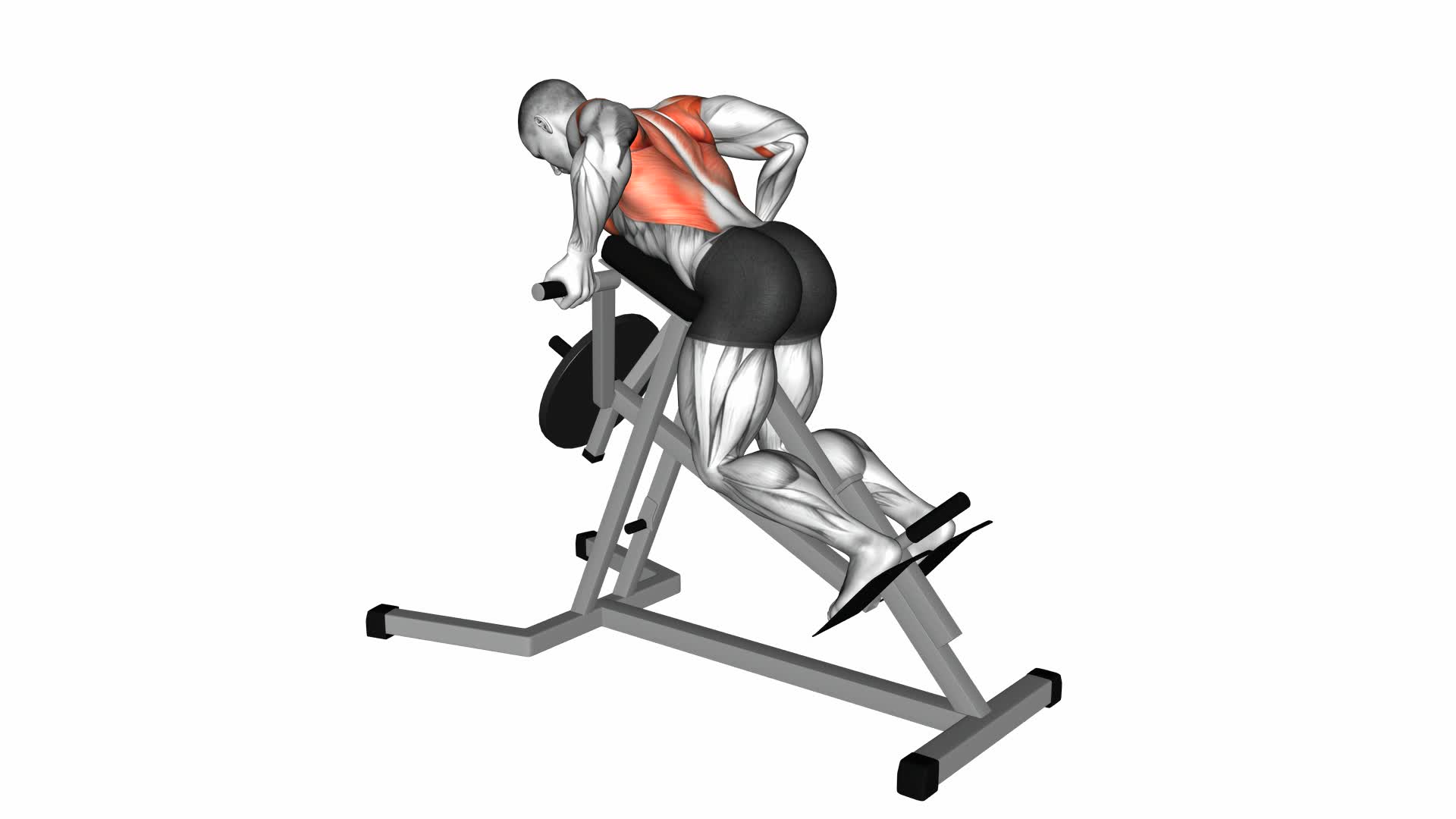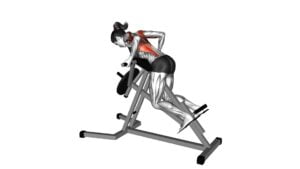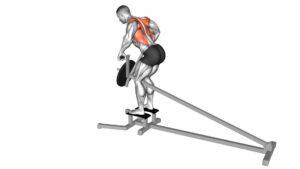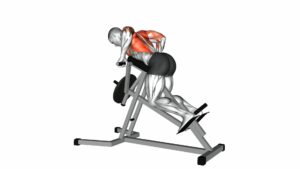Lever Reverse T-Bar Row – Video Exercise Guide & Tips

Are you looking for a new exercise to target your back muscles? Look no further than the Lever Reverse T-Bar Row!
Watch This Exercise Video
This video exercise guide will show you the proper form and technique, as well as provide helpful tips to get the most out of your workout.
Avoid common mistakes and learn advanced variations to challenge yourself even further.
Get ready to strengthen and tone your back with this effective exercise.
Let's get started!
Key Takeaways
- The Lever Reverse T-Bar Row is a beneficial exercise that strengthens back muscles, improves posture, engages multiple muscles in the back, and targets the upper back effectively.
- Alternative exercises can also target similar muscle groups and provide variety to your routine, helping to prevent muscle imbalances and challenge your body in different ways.
- Proper form and technique for the Lever Reverse T-Bar Row include maintaining a straight back, engaging the core, and pulling the weight towards the chest. The target muscles include the latissimus dorsi, rhomboids, trapezius, and biceps.
- It is important to use the appropriate equipment and setup for the exercise, avoid common mistakes such as using excessive weight or rushing through the exercise, and consider advanced variations and progressions to continue challenging the muscles and improving overall fitness.
Benefits of the Lever Reverse T-Bar Row
Experience the numerous benefits of the Lever Reverse T-Bar Row to strengthen your back muscles and improve your overall posture. This exercise is a fantastic choice for muscle activation and strength training. By performing the Lever Reverse T-Bar Row, you engage multiple muscles in your back, including the latissimus dorsi, rhomboids, and trapezius. These muscles play a crucial role in maintaining proper posture and spinal stability.
One of the primary benefits of the Lever Reverse T-Bar Row is its ability to target the muscles in your upper back effectively. This exercise allows you to retract your scapulae, which means pulling your shoulder blades together. This action helps strengthen the muscles responsible for pulling your shoulders back, resulting in improved posture.
Additionally, the Lever Reverse T-Bar Row activates your biceps and forearms as secondary muscles. This compound movement not only strengthens your back but also provides a great opportunity for overall upper body development.
To maximize the benefits of the Lever Reverse T-Bar Row, focus on maintaining proper form throughout the exercise. Keep your back straight, engage your core, and pull the weight towards your chest using your back muscles. Start with a weight that challenges you but allows you to complete the exercise with proper technique. Gradually increase the weight as you become stronger.
Incorporating the Lever Reverse T-Bar Row into your strength training routine will help you build a stronger back, improve your posture, and enhance overall muscle activation.
Proper Form and Technique for the Exercise
To perform the Lever Reverse T-Bar Row with proper form and technique, you need to focus on maintaining a straight back, engaging your core, and pulling the weight towards your chest using your back muscles. This exercise primarily targets your latissimus dorsi, rhomboids, trapezius, and biceps. It also engages your rear deltoids, erector spinae, and forearm muscles.
To incorporate the Lever Reverse T-Bar Row into your workout routine, start by setting up the T-bar machine with the desired weight. Stand in front of the machine, feet shoulder-width apart, and place your chest against the pad. Grasp the handles with an overhand grip, slightly wider than shoulder-width apart. This will be your starting position.
Keep your back straight and your core engaged throughout the exercise. Pull the handles towards your chest by retracting your shoulder blades and squeezing your back muscles. Pause for a moment at the top of the movement, then slowly lower the handles back to the starting position.
To maximize the effectiveness of the Lever Reverse T-Bar Row, aim for 3-4 sets of 8-12 repetitions. Remember to use a weight that challenges you but still allows for proper form. As with any exercise, it's important to warm up before starting and to listen to your body. If you experience any pain or discomfort, stop the exercise and consult a fitness professional.
Equipment and Setup for the Lever Reverse T-Bar Row
For the Lever Reverse T-Bar Row, you'll need a T-bar machine and the appropriate weight. The T-bar machine consists of a bar attached to a pivot point, allowing for a fluid range of motion during the exercise. It's important to adjust the machine to a height that allows you to comfortably reach the handles while keeping your feet firmly planted on the ground. Once you have set up the T-bar machine, choose the appropriate weight that challenges your muscles without compromising your form.
When it comes to variations of the Lever Reverse T-Bar Row, you can experiment with different grip widths and hand positions to target specific muscles. A wider grip will engage your back muscles more, while a narrower grip will target your biceps. Additionally, you can try using an overhand grip or an underhand grip to vary the muscle activation.
To maximize your results with the Lever Reverse T-Bar Row, focus on maintaining proper form throughout the exercise. Keep your back straight, engage your core, and retract your shoulder blades as you pull the weight towards your chest. Control the movement on both the eccentric and concentric phases, avoiding any jerking or swinging motions. Remember to breathe properly, inhaling as you lower the weight and exhaling as you pull it towards your chest.
Common Mistakes to Avoid
One common mistake to avoid in the Lever Reverse T-Bar Row is improper form.
Proper form is crucial to ensure that you engage the correct muscles and avoid potential injuries.
One common mistake that people make is using their lower back to lift the weight instead of their upper back and arms. This not only puts unnecessary strain on your lower back but also reduces the effectiveness of the exercise.
To correct this, focus on pulling with your upper back and arms, keeping your core tight and your spine neutral.
Another mistake to avoid is using too much weight. While it may be tempting to load up the machine, using excessive weight can compromise your form and increase the risk of injury.
Start with a weight that allows you to perform the exercise with proper form and gradually increase the weight as you get stronger.
Lastly, avoid rushing through the exercise. Take your time to perform each repetition with control and focus on squeezing your shoulder blades together at the top of the movement.
This will help maximize the benefits of the exercise and prevent any jerking or swinging motions.
Advanced Variations and Progressions
Try incorporating advanced variations and progressions into your Lever Reverse T-Bar Row routine to challenge your muscles and take your workout to the next level. Advanced modifications can help you continue to build strength and improve your overall fitness.
One option is to add weight to the exercise by using a weighted vest or holding a dumbbell between your feet. This will increase the resistance and provide a greater challenge for your muscles.
Another advanced modification is to perform the exercise on a stability ball. This will require your core muscles to work harder to stabilize your body, adding an extra level of difficulty to the exercise.
If you're looking for alternative exercises to include in your routine, consider trying bent over rows with dumbbells or barbells. These exercises target similar muscle groups and can help to further strengthen your back and arms.
Additionally, you can try single-arm rows or wide grip rows to change up the muscle recruitment and challenge your body in different ways.
Remember to always use proper form and technique when performing advanced variations and alternative exercises. Start with lighter weights or modifications and gradually increase the intensity as you become more comfortable and confident.
As with any exercise, it's important to listen to your body and make adjustments as needed to prevent injury. So, don't be afraid to push yourself and try new things to continue making progress in your fitness journey.
Frequently Asked Questions
How Many Sets and Reps Should I Do for the Lever Reverse T-Bar Row?
For the lever reverse T-bar row, the optimal rep range is typically between 8-12 reps per set. Start with a weight that challenges you but allows you to maintain proper form. Gradually increase the weight as you get stronger to continue progressing.
To increase intensity, you can also try adding more sets or reducing rest time between sets. Remember to listen to your body and adjust accordingly.
Can I Do the Lever Reverse T-Bar Row if I Have a Lower Back Injury?
If you have a lower back injury, it's important to modify the lever reverse T-bar row exercise to avoid further strain. Instead of performing the exercise with a lever, you can try using a resistance band or cable machine to target the same muscles without putting excessive stress on your lower back.
Additionally, there are alternative exercises such as seated cable rows or bent-over dumbbell rows that can be safer and more suitable for individuals with lower back injuries.
Is the Lever Reverse T-Bar Row Suitable for Beginners?
Yes, the lever reverse T-bar row is suitable for beginners.
It provides numerous benefits for beginners, such as targeting the back muscles and improving posture.
To ensure safety and avoid injury, beginners can make modifications by using lighter weights and focusing on proper form.
This exercise is a great way for beginners to build strength in their back muscles and gradually progress to more advanced exercises.
Can I Use Dumbbells Instead of a Barbell for the Lever Reverse T-Bar Row?
Yes, you can definitely use dumbbells instead of a barbell for the lever reverse T-bar row. Using dumbbells as an alternative to a barbell has its benefits.
It allows for a greater range of motion and can help to target different muscles in your back.
It also helps with balance and stability.
What Muscles Does the Lever Reverse T-Bar Row Primarily Target?
The lever reverse T-bar row primarily targets your back muscles, including the lats, rhomboids, and traps. By incorporating this exercise into your workout routine, you can strengthen and tone these muscles, improving your posture and overall upper body strength.
However, it's important to avoid common mistakes such as using too much weight, rounding your back, or pulling with your arms instead of your back. Focus on maintaining proper form for maximum benefits.
Conclusion
In conclusion, the lever reverse T-bar row is a highly effective exercise for building upper body strength and targeting the muscles in your back.
By following proper form and technique, using the right equipment and setup, and avoiding common mistakes, you can maximize the benefits of this exercise.
As you progress, you can also try advanced variations to challenge yourself even further.
Incorporate the lever reverse T-bar row into your workout routine for a stronger and more defined back.

Author
Years ago, the spark of my life’s passion ignited in my mind the moment I stepped into the local gym for the first time. The inaugural bead of perspiration, the initial endeavor, the very first surge of endorphins, and a sense of pride that washed over me post-workout marked the beginning of my deep-seated interest in strength sports, fitness, and sports nutrition. This very curiosity blossomed rapidly into a profound fascination, propelling me to earn a Master’s degree in Physical Education from the Academy of Physical Education in Krakow, followed by a Sports Manager diploma from the Jagiellonian University. My journey of growth led me to gain more specialized qualifications, such as being a certified personal trainer with a focus on sports dietetics, a lifeguard, and an instructor for wellness and corrective gymnastics. Theoretical knowledge paired seamlessly with practical experience, reinforcing my belief that the transformation of individuals under my guidance was also a reflection of my personal growth. This belief holds true even today. Each day, I strive to push the boundaries and explore new realms. These realms gently elevate me to greater heights. The unique combination of passion for my field and the continuous quest for growth fuels my drive to break new ground.



